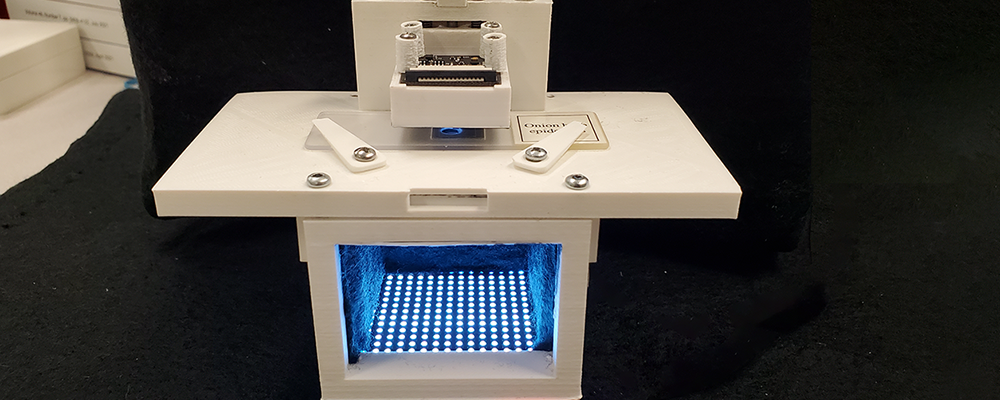Media
Contact
Communications Specialist
Faculty of Engineering
Spencer Engineering Building
Room 2072
Western University
Tel: 519-661-2111 ext. 87015
Email: engineeringcomms@uwo.ca
Western students developing a low-cost, sustainable solution for diagnosing malaria

Intermittent electricity. Humidity. Prohibitively high costs for microscopes and materials. Too few trained technicians to analyze blood samples in remote areas. Lack of rural health care sites.
When it comes to diagnosing malaria in rural and resource-constrained places in Africa, there are many barriers to confirming a potentially deadly disease by analyzing blood samples with a traditional microscope.
But one group of Western students is working on a low-cost microscope to make diagnosing malaria cheaper and more efficient.
“Nearly 250 million cases of malaria are diagnosed every year, with more than 700,000 deaths, including many who are children,” said Justin Yang, who recently graduated from Schulich School of Medicine & Dentistry’s Bachelor of Medical Sciences program, and is part of Western’s ‘Team ParaSight.’
“Rural villages have the most cases of malaria, for a variety of reasons – from a lack of pathologists to review the blood samples, to the prohibitive costs of buying traditional microscopes. We’re trying to change that.”
Team ParaSight is developing a laboratory-grade pathology microscope for a fraction of the cost, powered by computational imaging, said Yang. The team also includes Robin Cunningham, who just completed his fourth year of a dual degree in Mechatronic Systems Engineering and Medical Biophysics, and Samuel Farnum, who just finished his fourth year in Mechatronic Systems Engineering and the Ivey HBA Program.
“Our digital microscope prototype can be manufactured for around $200, compared to microscopes that are typically used to diagnose malaria, which cost between $10,000 and $20,000,” said Yang, who will enter Schulich Medicine’s MD program in the fall. “At the same time, we are also improving the microscope’s performance. So, the quality is being improved while the cost is dramatically lower.”
The team is affiliated with Western’s Frugal Biomedical Innovations (FBI) Program, a multi-disciplinary initiative designed to develop medical technologies that improve healthcare access for patients in remote and low-resource places.
"This was the first project, affiliated with our program, to be co-developed with one of our partners and we are excited by its invaluable impact towards the fight against Malaria," says Margaret Mutumba, program director of the FBI program.
"This innovative approach between Western's Team ParaSight and Dr. William Waswa at Mbarara University is a testament to the importance of frugal design and international collaboration in delivering equitable healthcare solutions to global challenges. And we see it as setting a template that many of our projects can follow."
"The Frugal Biomedical Innovations program allows students to get experience working with diverse teams on projects with a meaningful impact on the world. The FBI team has helped us better appreciate the implications of design decisions and how engineering can impact different communities."
- Robin Cunnigham, fifth-year BESc and BSc student
ParaSight initially stemmed from Yang’s participation in a summer research project led by Ian Cunningham, a professor in the Department of Medical Biophysics and Division of Medical Imaging and Biomedical Engineering. Working with Academics Without Borders and in collaboration with William Wasswa, a professor from Mbarara University of Science & Technology in Uganda, Professor Cunningham’s team was specifically focused on developing a low-cost digital light microscope for remote diagnosis of malaria.
The ParaSight student trio took the concept to the next level, by identifying the specific technologies required to make the microscope even more accessible in a low-cost context.
“I was going through the literature to see if there are any modalities or specific techniques that we can implement to reduce the cost of our device and one of the algorithms that I came across was ‘Fourier ptychography,’ which our prototype is based on,” said Yang.
While traditional microscopes use only a single light source, the Fourier ptychography approach uses hundreds of LED lights, which can capture much more detailed images of blood smears. This increases resolution and makes it easier to see the malaria parasite in red blood cells.
Yang credits their Ugandan collaborators with providing ideas, skills, expertise and knowledge of their communities’ needs to develop a product that has high potential to address their distinct challenges.
“We absolutely couldn’t do this without them,” he said.
Collaborators here and in Uganda already have functioning prototypes for the microscope, and the team is also looking ahead to a potentially game-changing way of incorporating AI into its design – which would enable diagnosis on the spot, lowering the need for a pathologist to examine slides and diagnose every case.
“It can take up to two hours for a trained pathologist to diagnose malaria, and the costs associated with that are very high – not to mention, these professionals just aren’t available in remote communities,” said Yang. “Down the road, we see potential for AI to detect whether a patient has malaria or not, right on the spot.”
ParaSight’s low-cost, sustainable solution for diagnosing malaria already garnered them attention when they won Western’s local World’s Challenge Challenge competition in the spring.
“What we have now is a prototype, but it’s just the microscope. It works great for research, but we need to make some modifications to turn it into a single, self-contained product you can use in any environment,” said Cunningham. “We are working on translating the software into a product, as well as making it functional as a single unit without needing a power supply.”
Cunningham believes projects like ParaSight can be incredibly valuable to an engineering education.
"The ability to not only make a real-world impact with a project but also learn better how to present ideas to a non-technical audience, get funding, and manage an interdisciplinary team is extremely valuable," he says.
"It’s exciting to see how something you have worked on can leave an impact and create value for people across the world."
Original story by Schulich Communications
View this post on Instagram

